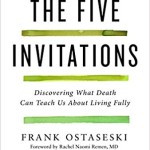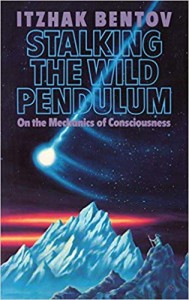Kate and I were recent participants in an amazing 4 day workshop at Joan Halifax’s Upaya Zen Center in Santa Fe. Entitled “Love and Death: Opening the Great Gifts.” Roshi Joan, a force of Nature, has spent many years working with death and the dying process and her co-teacher, Frank Ostaseski, founder of the Zen Hospice Program out of the San Francisco Zen Center at the beginning of the AIDS crisis in the 1980’s, is one of the world’s leading experts on compassionate hospice care.
Francisco Zen Center at the beginning of the AIDS crisis in the 1980’s, is one of the world’s leading experts on compassionate hospice care.
Frank’s recent book, “The Five Invitations” is a must read for anyone inhabiting a human body, as it presents his Buddhist/human approach to being with the dying with real life stories and his own personal experiences and challenges in diving into all the realms of human existence. The basic message is that our essential humanity, what the Buddhists call our basic goodness or Bodhicitta, and what Patanjali refers to as ‘drashtuh svarupe‘ is ever present beneath the roles and masks we present to the world and our selves and is the ultimate ground to meet all that arises with love, wisdom and compassion. But in order to discover this, we must be willing to open to all of the pain and suffering, in ourselves and the world around us, we repress and ignore out of fear.
From the perspective of the skandhas, this fear arises as the first of the skandhas, when we meet the mortality of the body and our egoic structures freak out. This leads to the second skandha we begin to strategize ways of avoiding acknowledging our own impermanence. First we divide our world into  likes and dislikes, or as Patanjali describes them in sutra II-7 and II-8, raga and dvesa, attachments and aversions, two of the five kleshas or afflictions we humans are subject to. In the third skandha, we respond impulsively to our likes and dislikes and busy ourselves in satisfying their demands. Of course, relief from our inner terror is impossible when we refuse to be present to it, and our suffering will continue, as long as we refuse to face our impermanence with an open heart.
likes and dislikes, or as Patanjali describes them in sutra II-7 and II-8, raga and dvesa, attachments and aversions, two of the five kleshas or afflictions we humans are subject to. In the third skandha, we respond impulsively to our likes and dislikes and busy ourselves in satisfying their demands. Of course, relief from our inner terror is impossible when we refuse to be present to it, and our suffering will continue, as long as we refuse to face our impermanence with an open heart.
To address our innate impermanence directly, and leave us with a lasting meaningful impression, Frank led a closing ritual on the last day, where the group was divided into three inner and outer circles. The inner circle sat on chairs facing out, and the outer circles sat on chairs facing inward, so you were always in a one on one situation with another person. We were all given a sheet of paper listing 5 affirmations from an old Theravadan Buddhist scripture based on Buddha’s oral teaching and translated by Thich Nhat Hahn, I believe. They read as follows:
I am of the nature of old age. There is no escape from growing old
I am of the nature of ill health. There is no escape from ill health.
I am of the nature to die. There is no escape from death.
All of those I love, and all I hold dear, are subject to change.
There is no escape from being separated from them.
My actions are my only true possessions.
There is no escape from the results of my actions.
My actions are the ground upon which I stand.
Persons on the inner circle, speaking slowly and from the heart, offered these verses as reminders to their partner on the outer circle. Then the person on the outer circle offered them back, heart to heart. This completed one cycle, with everyone both offering and receiving some deep truths about our own impermanence. After this, the outer circle rotated one station to the right and the process began again. When ‘in tune’, the verses were read simultaneously by all in the inner circles, and then all of the outer circles. So you had to be aware of not only your partner, but the whole group as well. By the end, there were 11 or 12 exchanges with different people, pointing to and holding the space of impermanence with an open and compassionate heart. Each exchange was unique, as we all embodied the process differently. It lasted a good half hour and left us all blown open. This was after all the preparatory work done in the previous days.
This was all good timing for me, as the day after I arrived back in Ojai, I received the results of my prostate biopsy and found out my cancer is the aggressive type and requires immediate attention. I am currently in the process or sorting out just what that means. When I first heard about the cancer back in July, there were still a lot of unknowns, as there are many types of prostate cancer, most being slow growing and manageable, and I had no idea which was mine. It was very disconcerting, but I was holding out for a ‘good’ prognosis. But when I saw a radiologist two weeks ago, as I was prepping for the biopsy, and he said “I wish I had seen you two years ago”, the abyss of impermanence opened up.
At least I was ‘somewhat‘ ready for it! All part of the human experience. I’ve always thought that the spiritual/cosmic side of life was much easier than the human side. The human condition is very messy. So I guess this is my graduate course in being human, and it involves transforming the energy of the skandhas, out of reactivity and impulsivity, and into, as Roshi Joan would say, an embodied presence with a ‘strong back, soft front’. The yogis would say ‘sthira sukham asanam‘. ‘Strong back, soft front’ is also very Taoist, paralleling the yang strength and the yin receptivity.
Roshi Joan contrasted this with the current dilemma in Japan where ‘maintaining face’ is so strongly imprinted in the culture that most everyone puts up a strong front, leaving a soft back unable to support challenging emotions. There is an epidemic of suicide in the young generation in Japan and the traditional monks are at a bit of a loss dealing with this. Roshi Joan was just in Japan presenting the emotionally challenging metaphor of ‘strong back, soft front’ at her home Soto Temple. She is the first woman honored to ever address all these male zen monks. The ‘yin’ softening front body, allowing our emotions and feelings to be known, is very much a feminine virtue that all cultures desperately need to embody.
Grief, sadness, greed, jealousy, anger and many more of our emotional experiences need to be fully embodied and integrated into our moment to moment unfolding to keep us from falling back into the delusional pursuit of the likes and dislikes. The impulse to avoid our ‘dark side’ and stay in delusion, skandha three, is powerful, so we become masters at being distracted. There is no cultural impetus to be with difficulty, so the pursuit of pleasure and the avoidance of pain become a powerful field shaping our moment to moment behavior. But the secrets of inner peace and true happiness are only uncovered when we face the messiness of life with wisdom and compassion.
The primary practices Frank and Joan taught us during the four days, to help us work with our emotions and cultivate an open heart, were meditation and reciting and embodying the Brahma Viharas, (sutra I-33 for the yogis, metta for the Buddhists). We’ll return to the Brahma Viharas in part II of this blog post.
Mediation practice in a zendo is usually silent, but we had several occasions where Frank would lead guided meditations during zazen sessions, and one I found very helpful. It involves four simple instructions that circulate in and around each other: pause, relax, open and allow.
Pause: Every breath has two pauses; at the end of the in-breath, and at the end of the out-breath. In Itzak Bentov’s brilliant book, “Stalking the Wild Pendulum”, (one of my all time favorites,) the pauses, when the pendulum naturally comes to rest as it is about to change directions, are portals to the infinite to drashtuh svarupe. These pauses are also explored in depth during the kumbhakas in pranayama practice. Frank offered an example in real life of this process. Before he would enter a room with a hospice patient, he would check to see on what side of the door the hinges were. If on the left, he would enter to room left foot first, and vice versa. As he explained, rather than being an expression of OCD, he wanted to make sure he always paused and found a moment of stillness before he entetred, so he wouldn’t walk in with preconceived notions of what he was about to see, what to do or how to present himself. He wanted to lead with his humanity, so he paused before acting.
during the kumbhakas in pranayama practice. Frank offered an example in real life of this process. Before he would enter a room with a hospice patient, he would check to see on what side of the door the hinges were. If on the left, he would enter to room left foot first, and vice versa. As he explained, rather than being an expression of OCD, he wanted to make sure he always paused and found a moment of stillness before he entetred, so he wouldn’t walk in with preconceived notions of what he was about to see, what to do or how to present himself. He wanted to lead with his humanity, so he paused before acting.
The pause is the immediate antidote to impulsivity. The impulses are mostly unconscious and deeply habituated, so the pause momentarily stops that. In my meditation, I call call the pauses ‘getting off the train (of thought)’. The distraction of our own thought patterns can be disrupted if we continually remind ourselves to pause, get off the train and wait. As every breath has a pause, we always get to begin again. Beginner’s mind in every pause.
Relax: Amidst the pause we can add ‘relax’. We may be momentarily ‘off the train’, but there may still be an underlying need to ‘make something happen’. I should be doing this pose, doing this meditation practice, so I get it right. In sutra II-47, Patanjali describes the next step after settling into ‘sthira and sukham as ‘stop ‘trying’ and just be.’
II-47 pra-yatna shaithilyaananta sam-aa-pattibhyaam
With the release of effort and absorption in the limitless (posture is mastered).
Relax. Posture/presence is a state of being, not doing. We need to remind ourselves again and again to just relax. I can be a bit compulsive about needing to ‘fix’ or ‘improve’ my sitting posture, so this is a challenging instruction for me. If something needs attention, take care of it, but don’t obsess over the details. Relax does not mean collapse, but to find what is called in Taoism, wu wei, effortless effort. Ananta in sutra II-47 is the Tao. Relax and let the Tao hold and nurture you. Be aligned with the flow of life and Trust it. This trust is described in sutra I-20 as shraddha, one of the five ‘yoga vitamins’
Open: From the release of efforting, we may feel places that are still holding on, resisting the flow of qi/prana/aliveness through our bodies. The instruction ‘open’ is an invitation to find some space in and around the holding, around the fear, to open to the deeper aspects of the breath waiting to emerge. We may feel this as an expansion out of structure into energy, or out of energy flow into the expansive energy fields. Or it may be just holding the fear in an open heart.
Allow: When some are of the body is holding on, there is usually some pain or suffering associated with it. ‘Allow’ gives permission for the pain or difficulty to be felt honestly, with an open heart. I like the word allow much better than surrender. Surrender, a term often used in this context, can feel like ‘giving up’, whereas allow seems to me to be non-judgmentally open. Frank mentioned the same thing.
Isvara Pranidhana , first mentioned in sutra I-23 from the Yoga Sutras, invites us to allow our own innate Divinity to merge with Divinity as wholeness, in any and all life situations. It is actually never separate. We just believe that it is. Namaste. Our divine wholeness is ever-present, effortlessly. Nothing to do, but feel, open to the breathing, open to Mother Earth, open to the cosmic heart. Find the strength to be present to whatever arises.
I find myself going back and forth with whether to begin with Pause or Relax. They seem to work together. As they become established, Open and Allow can come forth and deepen the practice, until you get distracted and then another pause is needed. Find any way to use these invitations to help your meditation practice and then put them to use in your day to day life. Pause, Relax, Open, Allow

